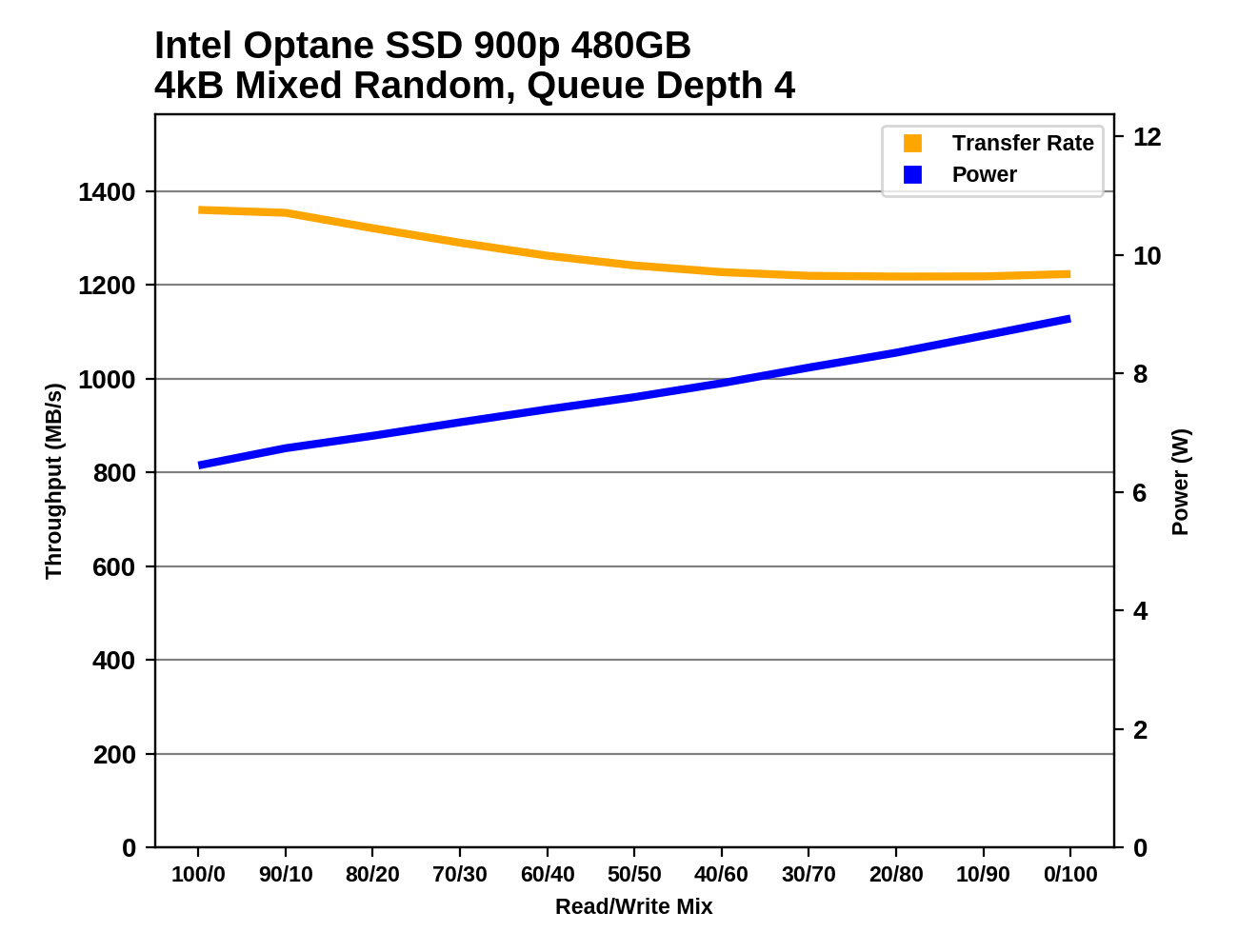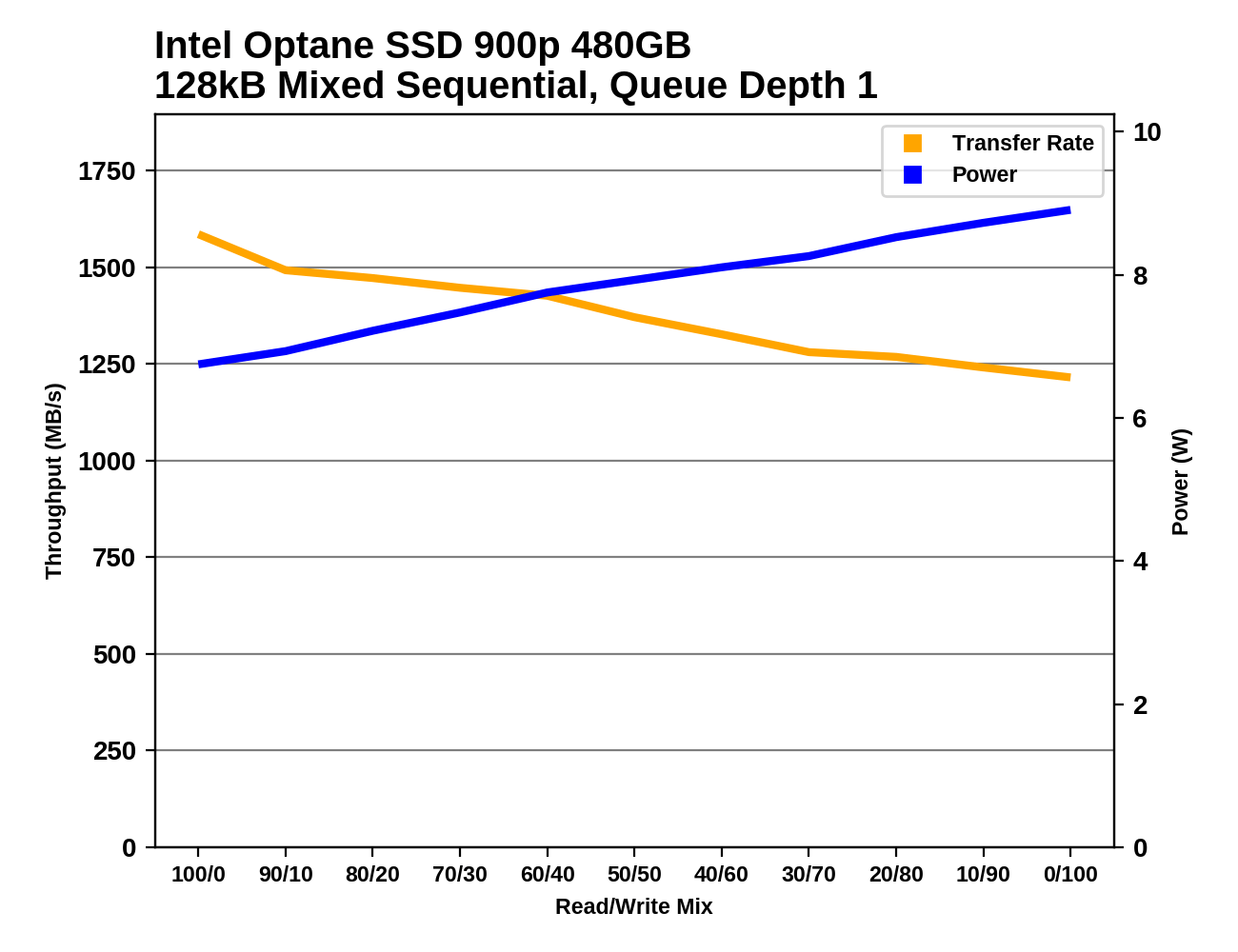The Intel Optane SSD 900p 480GB Review: Diving Deeper Into 3D XPoint
by Billy Tallis on December 15, 2017 12:15 PM ESTMixed Random Performance
Our test of mixed random reads and writes covers mixes varying from pure reads to pure writes at 10% increments. Each mix is tested for up to 1 minute or 32GB of data transferred. The test is conducted with a queue depth of 4, and is limited to a 64GB span of the drive. In between each mix, the drive is given idle time of up to one minute so that the overall duty cycle is 50%.

Since this mixed random I/O test is conducted at the relatively low queue depth of four, the Optane SSDs have a large performance advantage, and even the tiny Optane Memory M.2 does well (though it has to run a slightly modified version of the test due to its low capacity). The Optane SSDs are more than three times faster overall than the highest-scoring flash-based SSD.

The Optane SSDs have a substantial power efficiency lead on the mixed random I/O test, but it is small enough that flash-based SSDs could conceivably catch up with a generation or two of improvements. As usual, the 480GB model has clearly lower efficiency because its minor performance advantage doesn't outweigh the power cost the extra 3D XPoint memory chips.
 |
|||||||||
Both capacities of the Intel Optane SSD 900p show a modest decline in performance as the workload becomes more write-heavy, and a fairly linear increase in power consumption. The 480GB model's power consumption grows slightly faster than the 280GB model, leading to a 0.9W gap at the end of the test.
Even the Intel SSD 750 draws substantially less power for most of the test, though it catches up at the very end. The flash-based M.2 NVMe SSDs are mostly drawing a fraction of what the Optane SSDs require. In terms of performance, none of the flash-based SSDs come at all close to the Optane SSDs until the very end of the test, where many are able to deliver good random write speed.
Mixed Sequential Performance
Our test of mixed sequential reads and writes differs from the mixed random I/O test by performing 128kB sequential accesses rather than 4kB accesses at random locations, and the sequential test is conducted at queue depth 1. The range of mixes tested is the same, and the timing and limits on data transfers are also the same as above.

The Intel Optane SSD 900p is much faster on the mixed sequential I/O test than any consumer flash-based SSD. Samsung's best drives are slower by a third, and it's downhill from there for NAND flash. The 480GB model actually performed slightly worse on this test than the 280GB model, but the difference is small enough it may simply be due to variation between runs.

The power efficiency of the Optane SSD 900p on the mixed sequential I/O test is good but not quite at the top of the charts. Instead, it is on par with the Samsung 960 EVO, which sacrificed a bit of efficiency to improve performance relative to the Samsung 950 PRO.
 |
|||||||||
The 280GB Optane SSD 900p was a bit faster than the 480GB overall but a bit less steady over the course of the test. The scaling of the Optane SSDs is quite similar to the results from the mixed random test: a gradual decline in performance as the proportion of writes increases, and a linear increase in power consumption. The overall performance level is significantly higher than for the random I/O test.
The flash-based SSDs can get much closer to competing with the Optane SSDs on this mixed sequential test than on the mixed random test. Several drives have sequential read speeds that approach that of the Optane SSDs, and a few have higher sequential write performance. But through the middle portions of the test, the flash-based SSDs all lose a lot of their performance for at least a few phases of the test, while the Optane SSD has no acute performance weakness.










69 Comments
View All Comments
eddman - Sunday, December 17, 2017 - link
That graph explains the situation perfectly. Even if the media's latency was somehow magically reduced to zero, the total storage latency would still be only about 6 times better.It's all pointless though; ddriver's personal hatred towards intel and "the corporations" prevents him from thinking differently. As soon as he finds a number that is different from what was mentioned in the promotional materials, the first thing he does is to start shouting "liar, liar".
P.S. I have zero love for corporations and can't stand when one takes advantage of the users. What I also can't stand is a person spreading unsubstantiated claims and spamming a technology website's comment section to offload his hate in order to feel better.
tuxRoller - Friday, December 15, 2017 - link
Also z nand appears to be mlc cells operating in SLC mode, and that's still slower than first gen xpoint.hescominsoon - Friday, December 15, 2017 - link
Intel has walked back the 100x bs claims. Also notice how micro(their partner in this venture) has NOT released their side of this product?https://semiaccurate.com/?s=optane
tuxRoller - Saturday, December 16, 2017 - link
They walked them back? Maybe for these nvme products, though I've not seen anything about that. The real test is how well they'll do as direct addressed memory when used in the DIMM configuration.Reflex - Friday, December 15, 2017 - link
SLC has no significant advantages over Optane. Optane is nearly across the board a better performer, often by a significant margin, than any commercial NAND technology. The two drawbacks that are important right now are power consumption and cost (these are also drawbacks of SLC for the record)The complaints about Intel's 'hype' are misconstrued. There is a huge difference between discussing what a technology is capable of, and what individual products derived from that technology can deliver. That some people had reading comprehension problems is not Intel's problem, they are delivering what they promised, and as the rest of the supporting infrastructure improves over time we know based on their initial statements that Optane/PCM can scale to match it.
CheapSushi - Friday, December 15, 2017 - link
The industry is trying. It's called Z-NAND.ddriver - Friday, December 15, 2017 - link
Which is MLC...Samsung realized nobody is catching up in the nand market and decided to push consumer, high end and mainstream enterprise a notch down to TLC.
So now that MLC is only a "high end enterprise" thing in their portfolio, they decided to pimp it up with a new moniker - z-nand. Alas, it is just good old MLC with a barely incremental controller. And claim that it has anything to do with SLC performance - which it does as much as an a race horse harness makes an old donkey faster.
They REALLY aren't trying.
CheapSushi - Saturday, December 16, 2017 - link
It's MLC & TLC 3D NAND treated exactly like SLC (1 bit per cell) with a better controller and special sauce, effectively making it as if it was SLC in the first place and a better SLC driver than previous SLC drives that came out. So what is the issue? It's not a completely separate NAND production line?ddriver - Saturday, December 16, 2017 - link
Do you realize parroting nonsense you are clearly completely ignorant of doesn't win you bonus points?There is no such thing, you have to compromise one for the sake of the other. It is just more mature and a tiny bit better than previous gen MLC, but it is not even half of what can be squeezed of contemporary SLC.
"Special sauce"? It is sad to see average Joe hans't moved up a bit since the middle ages.
drajitshnew - Saturday, December 16, 2017 - link
No "ryzen" in opposition to their "core". The flash industry is in a race to see who can make the CHEAPEST PoS